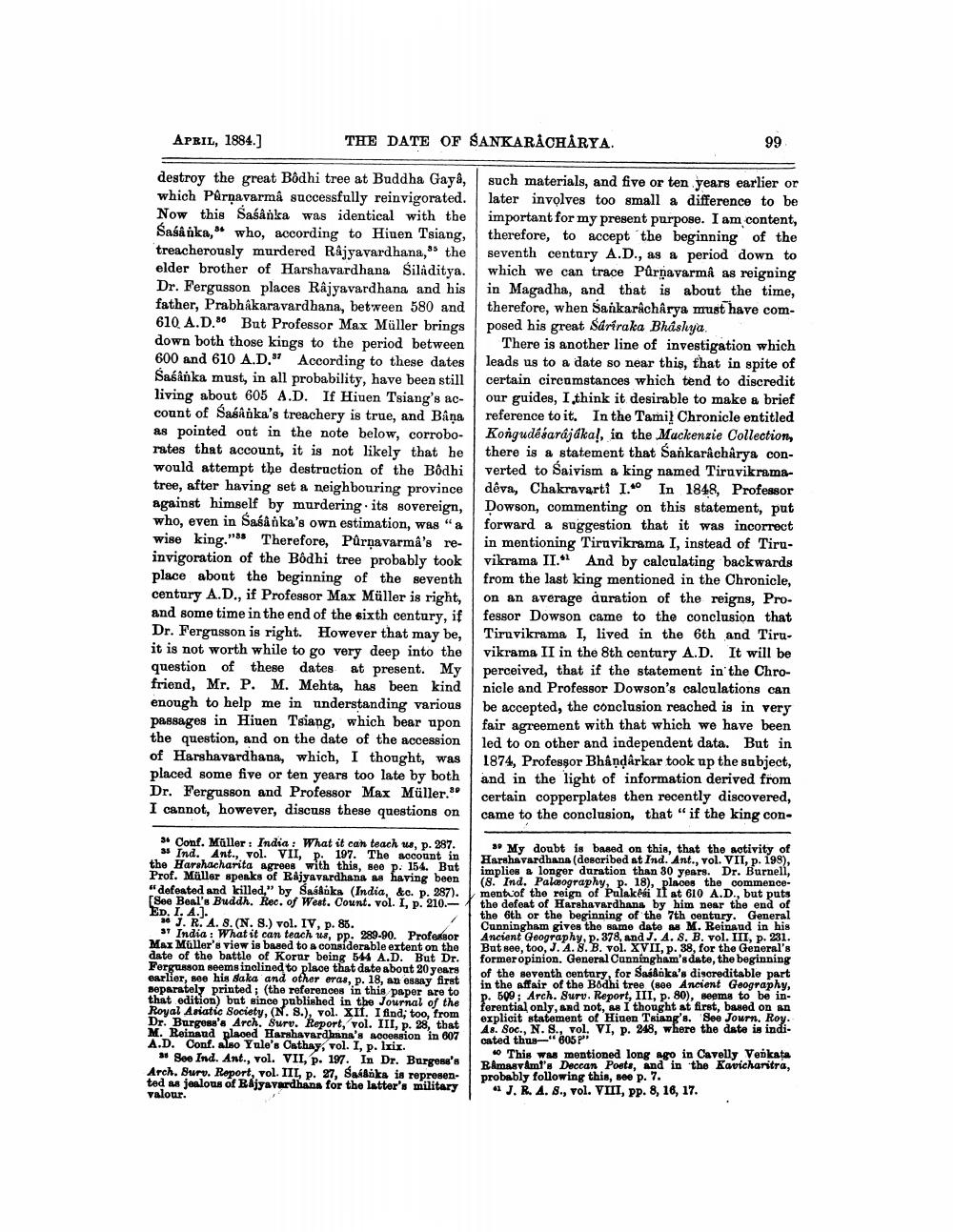________________
THE DATE OF SANKARACHARYA.
APRIL, 1884.]
destroy the great Bôdhi tree at Buddha Gaya, which Pârnavarmâ successfully reinvigorated. Now this Sasanka was identical with the Sasanka," who, according to Hiuen Tsiang, treacherously murdered Rajyavardhana," the elder brother of Harshavardhana Siladitya. Dr. Fergusson places Râjyavardhana and his father, Prabhakaravardhana, between 580 and 610 A.D. But Professor Max Müller brings down both those kings to the period between 600 and 610 A.D." According to these dates Sasanka must, in all probability, have been still living about 605 A.D. If Hiuen Tsiang's account of Sasanka's treachery is true, and Bâna as pointed out in the note below, corroborates that account, it is not likely that he would attempt the destruction of the Bodhi tree, after having set a neighbouring province against himself by murdering its sovereign, who, even in Sasanka's own estimation, was "a wise king." "Therefore, Pârnavarmâ's reinvigoration of the Bôdhi tree probably took place about the beginning of the seventh century A.D., if Professor Max Müller is right, and some time in the end of the sixth century, if Dr. Fergusson is right. However that may be, it is not worth while to go very deep into the question of these dates at present. My friend, Mr. P. M. Mehta, has been kind enough to help me in understanding various passages in Hiuen Tsiang, which bear upon. the question, and on the date of the accession of Harshavardhana, which, I thought, was placed some five or ten years too late by both Dr. Fergusson and Professor Max Müller." I cannot, however, discuss these questions on
3 Conf. Müller: India: What it can teach us, p. 287. 35 Ind. Ant., vol. VII, p. 197. The account in the Harshacharita agrees with this, see p. 154. But Prof. Müller speaks of Rajyavardhana as having been "defeated and killed," by Sasanka (India, &c. p. 287). [See Beal's Buddh. Rec. of West. Count. vol. I, p. 210.ED. I. 4.].
26 J. R. A. 8. (N. 8.) vol. IV, p. 85.
37 India: What it can teach us, pp. 289-90. Professor Max Müller's view is based to a considerable extent on the date of the battle of Korur being 544 A.D. But Dr. Fergusson seems inclined to place that date about 20 years earlier, see his Saka and other eras, p. 18, an essay first separately printed; (the references in this paper are to that edition) but since published in the Journal of the Royal Asiatic Society, (N. 8.), vol. XII. I find, too, from Dr. Burgess's Arch. Surv. Report, vol. III, p. 28, that M. Reinaud placed Harshavardhana's accession in 607 A.D. Conf. also Yule's Cathay, vol. I, p. Ixix.
38 See Ind. Ant., vol. VII, p. 197. In Dr. Burgess's Arch. Surv. Report, vol. III, p. 27, Saidika is represented as jealous of Rajyavardhana for the latter's military
valour.
99
such materials, and five or ten years earlier or later involves too small a difference to be important for my present purpose. I am content, therefore, to accept the beginning of the seventh century A.D., as a period down to which we can trace Pârnavarmâ as reigning in Magadha, and that is about the time, therefore, when Sankaracharya must have composed his great Sariraka Bhashya.
There is another line of investigation which leads us to a date so near this, that in spite of certain circumstances which tend to discredit our guides, I think it desirable to make a brief reference to it. In the Tamil Chronicle entitled Kongudésarajaka!, in the Mackenzie Collection, there is a statement that Sankaracharya converted to Saivism a king named Tiruvikramadêva, Chakravarti I. In 1848, Professor Dowson, commenting on this statement, put forward a suggestion that it was incorrect in mentioning Tiruvikrama I, instead of Tiruvikrama II. And by calculating backwards from the last king mentioned in the Chronicle, on an average duration of the reigns, Professor Dowson came to the conclusion that Tiruvikrama I, lived in the 6th and Tiruvikrama II in the 8th century A.D. It will be perceived, that if the statement in the Chronicle and Professor Dowson's calculations can be accepted, the conclusion reached is in very fair agreement with that which we have been led to on other and independent data. But in 1874, Professor Bhandarkar took up the subject, and in the light of information derived from certain copperplates then recently discovered, came to the conclusion, that "if the king con
39 My doubt is based on this, that the activity of Harshavardhana (described at Ind. Ant., vol. VII, p. 198), implies a longer duration than 30 years. Dr. Burnell, (8. Ind. Paleography, p. 18), places the commencement of the reign of Pulakési II at 610 A.D., but puts the defeat of Harshavardhana by him near the end of the 6th or the beginning of the 7th century. General Cunningham gives the same date as M. Reinaud in his Ancient Geography, p. 378, and J. A. S. B. vol. III, p. 231. But see, too, J. A. 8. B. vol. XVII, p. 38, for the General's former opinion. General Cunningham's date, the beginning of the seventh century, for Sasanka's discreditable part in the affair of the Bodhi tree (see Ancient Geography, p. 509; Arch. Surv. Report, III, p. 80), seems to be inferential only, and not, as I thought at first, based on an explicit statement of Hinen Teiang's. See Journ. Roy. 48. Soc., N. S., vol. VI, p. 248, where the date is indicated thus-" 605 P**
This was mentioned long ago in Cavelly Venkata Bamasyami's Deccan Poets, and in the Kavicharitra, probably following this, see p. 7.
1 J. R. A. 8., vol. VIII, pp. 8, 16, 17.




